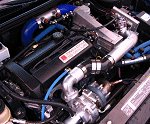

|
Street Class Unlimited Class
DOHC SOHC Ion Updated 1/05 For the most recent list of the fastest five cars click here. |
Deciphering Compressor Maps - Page 2by: TitanEngine airflowIn order to determine the proper turbo size you will need to estimate the engine airflow requirements. This can be accomplished with the basic equation: (CID x RPM) / 3456 = CFM Variables The CID for the 1.9 liter engine will be a constant
value of 116 unless the engine's cylinders have been bored larger.
I have chosen to use 6000rpms as the maximum rpm value simply because
the power curve drops off quickly after that. (116 x 6000) / 3456 = 201.39 CFM The 1.9 liter engine will flow 201.39 CFM of air assuming 100% volumetric efficiency (VE). Since most street engines have a VE between 80-90% the equation will have to be altered to reflect this lower VE. Splitting the difference we will assume the 1.9 liter engine possesses a VE of 85%. 201.39 x 0.85 = 171.18 CFM Calculating for 85% VE shows that the engine actually flows 171.18 CFM. To compare the airflow requirement against the compressor map you will need to convert CFM to lbs/min by multiplying the corrected CFM by 0.069 171.18 x 0.069 = 11.81 lbs/min 11.81 lbs/min represents your x-axis value at 6000rpms.. Common displacements
To properly determine which turbo housing best suits your application you will need to plot several data points on the compressor map. I would suggest using the following rpms 2000, 3000, 4000, 5000, and 6000. Substituting the rpm values into the formula produces the following table. 1.9 liter engine
As an interesting side note, whenever you solve for the engine airflow requirements you can move the decimal over to the right one place you end up with the engine's horsepower. In our example moving the decimal one place to the right yields 118.1 horsepower for the stock engine, which is a pretty close estimate of the factory's horsepower claim. Pressure RatioNow that we know the amount of airflow through the engine we need to calculate the desired pressure ratio (P2/P1). This can be easily accomplished with the following formula: (P1 + P2) / P2 = Pressure Ratio Variables Plugging in a desired boost of 7psi we get: (7 + 14.7) / 14.7 = 1.48 This will give you a y-axis value of 1.48 for 7psi
of boost. |
|




